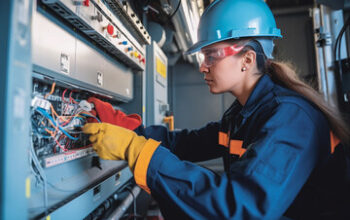The sun’s rays provide us with an incredible amount of energy. Solar can power our homes, buildings and even cars.
It’s a renewable resource that can be used everywhere on the planet. The cost of solar has dropped dramatically thanks to innovations in technology and materials. It can even increase property value. Click the Darwin Solar to know more.

A solar cell is a semiconductor device that converts sunlight into electricity. It consists of two layers of a light-absorbing material, usually silicon. The silicon is treated in a process called “doping” to create an electric field, with one side of the cell having a net positive charge and the other side having a net negative charge. The electric field acts like a diode, forcing the loose electrons to flow through the cell in a certain direction, producing electricity. Metal plates on the sides of the solar cells collect these electrons and transfer them to wires, which are connected to a power inverter. The inverter then converts the electrons into usable household electricity.
Silicon is the most common photovoltaic (PV) material used in solar cells. Its atoms are organized in a crystal lattice, which gives the material its structural integrity and efficiency. Silicon is the second most abundant element on Earth, and it is used in computer chips as well. In addition to silicon, there are other semiconductor materials used in PV cells, including cadmium telluride (CdTe) and copper indium gallium diselenide (CIGS).
To make a solar cell work, it must absorb and separate electrons from holes. Sunlight strikes the front surface of the cell, causing some of the electrons to be ejected. This ejection forms an electric field, with the free electrons on the n-type silicon moving to the p-type silicon. The p-type silicon now has holes that need to be filled, so the free electrons on the n-type layer move to fill them.
This process is called “depletion zone.” When the electrons are drawn to the n-type silicon, they create electricity. This electricity is then conducted by the metal wires to the outside of the solar cell, where it can be connected to an external power supply.
To increase the efficiency of solar cells, manufacturers apply various coatings to them. Anti-reflection coatings, for example, decrease the reflection of light from the cell surface. Other coatings, such as a layer of plasma-enhanced chemical vapor deposition, passivation, and textured surfaces, help reduce carrier recombination. Some solar cells also have textured front surfaces that, like anti-reflection coatings, increase the amount of sunlight they absorb.
Solar panels
The solar cells in a solar panel convert the sun’s energy into electricity. Individual solar cells are usually grouped together into a module, which is framed and wired to create a complete solar power system. The system includes an inverter, which converts the direct current into alternating current, and a battery to store power for later use. Solar panels are available in a wide range of sizes and shapes, depending on the application. Some are designed to blend in with existing roofs, while others may be a noticeable addition to the structure.
The most common type of solar panel uses crystalline silicon semiconductors to produce power. This technology accounts for about 95% of the world’s solar panels. However, emerging technologies are creating new options for the future of solar power. Some of these are thin-film solar cells that produce high energy conversion for a lower cost. Others are based on compound semiconductors such as gallium arsenide and copper indium diselenide.
Using solar panels to generate electricity is a green solution that allows homeowners to tap into a renewable, non-polluting energy source. The cost of solar panels is falling and the savings can be substantial over time. In many cases, the money that is saved from reduced utility bills more than offsets the cost of solar installation.
Solar panels are easy to maintain and can last up to 25 years with minimal maintenance. They are also low-emission, producing only a small fraction of the carbon dioxide that is released during production of conventional fossil fuels. Solar panels are an excellent alternative to other energy sources, including coal and nuclear power.
In addition to their environmental benefits, solar panels can increase a home’s resale value and reduce utility costs. However, they must be properly oriented to the sun’s position and inclination to maximize energy production. Depending on the application, this may mean mounting solar panels at an angle close to the area’s latitude to capture the maximum amount of sunlight during the year. Alternatively, motor-driven tracking systems can be used to continuously reorient the solar panels as the sun moves throughout the day and season.
Solar furnaces
Solar furnaces use curved mirrors to collect and concentrate sunlight into a high-temperature stream. They can reach temperatures above 3800°C, which is higher than the melting point of most metals. This process is a clean alternative to combustion or electric furnaces, as it produces no pollution or residues. The system is also highly energy-efficient, as it uses the sun’s radiation to heat materials.
The first experimental solar furnace was built in 1949 by Felix Trombe at the Laboratoire de l’Energie Solaire at Mont Louis, France. Its success led to the construction of the larger solar furnace at Odeillo, which was commissioned in 1969.
Solar furnaces require a large number of flat mirrors called heliostats to track the sun and focus its power onto the primary concentrator, which is made of dozens of individual curved mirrors. This allows the furnace to achieve extremely high temperatures without losing efficiency. The first commercial solar furnaces used this technology to melt zinc and tin base alloys.
Today, many different kinds of solar furnaces are available. These systems can be used to generate electricity, melt metals, and produce fuel by converting water into steam. In addition to providing energy, these technologies can also help reduce greenhouse gas emissions.
Some of the most important components of a solar furnace are the glass panes and aluminum frame. These components must be kept in good condition to ensure efficient operation. Inspect them regularly for cracks or breaks. These small cracks can significantly impact the performance of your solar furnace by allowing heat to escape. Also, check the sealant around the glass to ensure that it has not cracked or dried.
A new type of solar furnace has recently been developed, and it can reach extremely high temperatures. Its unique design allows it to be fabricated quickly and inexpensively. The design is based on a solar trough with a parabolic reflector, but it has a smaller diameter than a conventional trough. This smaller mirror provides a better optical quality and a lower temperature gradient, which is essential for high-performance applications.
The National Renewable Energy Laboratory’s (NREL) High-Flux Solar Furnace (HFSF) is a unique 10-kilowatt optical solar concentrator that harnesses concentrated sunlight to test high-temperature processes and applications. The HFSF is located on the top of South Table Mountain.
Solar power towers
Solar power towers are a type of concentrated solar power (CSP) plant. They use a field of tracking mirrors called heliostats to collect sunlight and focus it on a central receiver located at the top of a tall solar tower. Solar power tower plants use a large amount of land, but require significantly less water than hydroelectric dams and coal-powered power stations.
The heliostats are arranged in a circular array with each mirror belonging to a slightly different size parabola. This arrangement allows for a very high concentration factor, which allows the solar power tower to reach temperatures of 800oC and above. This is far higher than a solar trough plant which can only achieve around 600oC.
A heat transfer medium is then used to absorb the high-temperature solar energy that has been collected by the heliostats and central receiver. It is then converted to electricity using a conventional steam cycle. The resulting steam is used to spin a turbine generator and produce electricity. The steam can also be stored for many hours and used at night or on cloudy days when the solar energy is not sufficient to make power.
The heat transfer medium used for most modern types of solar power towers includes steam/water, molten salts and liquid sodium. Early solar power tower designs focused the suns rays to heat plain water and then used the resulting generated steam to drive a turbine generator. Today, solar towers usually use molten salts such as sodium nitrate (NaNO3) to store the energy which can then be used for generation at any time of day or night.
Solar Power Towers are currently the newest form of solar technology and offer significant advantages over other forms of renewable energy. They can operate in locations that would not be feasible for other forms of solar energy because they are able to capture more of the sun’s radiation than traditional flat-panel systems. They are particularly effective in the desert, and they can perform well in winter, during overcast or cloudy weather and when the sun is low on the horizon.


